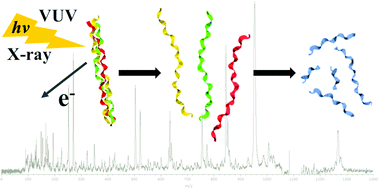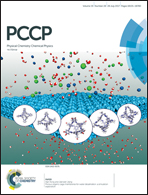Single-photon absorption of isolated collagen mimetic peptides and triple-helix models in the VUV-X energy range†
Abstract
Cartilage and tendons owe their special mechanical properties to the fibrous collagen structure. These strong fibrils are aggregates of a sub-unit consisting of three collagen proteins wound around each other in a triple helix. Even though collagen is the most abundant protein in the human body, the response of this protein complex to ionizing radiation has never been studied. In this work, we probe the direct effects of VUV and soft X-ray photons on isolated models of the collagen triple helix, by coupling a tandem mass spectrometer to a synchrotron beamline. Single-photon absorption is found to induce electronic excitation, ionization and conversion into internal energy leading to inter- and intra-molecular fragmentation, mainly due to Gly-Pro peptide bond cleavages. Our results indicate that increasing the photon energy from 14 to 22 eV reduces fragmentation. We explain this surprising behavior by a smooth transition from excitation to ionization occurring with increasing photon energy. Moreover, our data support the assumption of a stabilization of the triple helix models by proline hydroxylation via intra-complex stereoelectronic effects, instead of the influence of solvent.

- This article is part of the themed collection: XUV/X-ray light and fast ions for ultrafast chemistry


 Please wait while we load your content...
Please wait while we load your content...